Joseph Kittinger
| Joseph W. Kittinger II | |
|---|---|
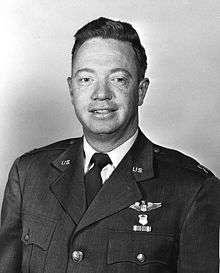 Colonel Joseph W. Kittinger II, USAF (pictured as a Captain) First person to conduct stratospheric space diving | |
| Nickname(s) | Red |
| Born |
July 27, 1928 Tampa, Florida, U.S. |
| Allegiance | United States of America |
| Service/branch |
|
| Years of service | 1950–1978 |
| Rank |
|
| Battles/wars | Vietnam War |
| Awards |
|
Joseph William Kittinger II (born July 27, 1928) is a retired Colonel in the United States Air Force and a USAF Command Pilot. Following his initial operational assignment in fighter aircraft, he participated in Project Manhigh and Project Excelsior in 1960, setting a world record for the highest skydive from a height greater than 31 kilometres (19 mi).[1] He was also the first man to make a solo crossing of the Atlantic Ocean in a gas balloon.
Serving as a fighter pilot during the Vietnam War, he achieved an aerial kill of a North Vietnamese MiG-21 jet fighter and was later shot down himself, spending 11 months as a prisoner of war in a North Vietnamese prison.
In 2012, at the age of 84, he participated in the Red Bull Stratos project as capsule communicator, directing Felix Baumgartner on his record-breaking 39-kilometer (24 mi) freefall from Earth's stratosphere, exceeding Kittinger's earlier freefall in 1960.
Early life and military career
Born July 27, 1928, in Tampa, Florida, Kittinger was educated at The Bolles School in Jacksonville, Florida, and the University of Florida. He became fascinated with planes at a very young age and soloed in a Piper Cub by the time he was 17. After racing speedboats as a teenager, he entered the U.S. Air Force as an Aviation Cadet in March 1949. On completion of aviation cadet training in March 1950, he received his pilot wings and a commission as a Second Lieutenant. He was subsequently assigned to the 86th Fighter-Bomber Wing based at Ramstein Air Base in West Germany, flying the F-84 Thunderjet and F-86 Sabre.
In 1954 Kittinger was transferred to the Air Force Missile Development Center (AFMDC) at Holloman AFB, New Mexico. It was during this assignment that he flew the observation/chase plane that monitored flight surgeon Colonel John Stapp's rocket sled run of 632 mph (1,017 km/h) in 1955. Kittinger was impressed by Stapp's dedication and leadership as a pioneer in aerospace medicine. Stapp, in turn, was impressed with Kittinger's skillful jet piloting, later recommending him for space-related aviation research work. Stapp was to foster the high-altitude balloon tests that would later lead to Kittinger's record-setting leap from over 102,800 feet (31,300 m). In 1957, as part of Project Manhigh, Kittinger set an interim balloon altitude record of 96,760 feet (29,490 m) in Manhigh I, for which he was awarded his first Distinguished Flying Cross.
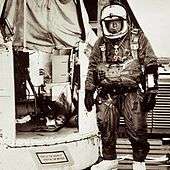
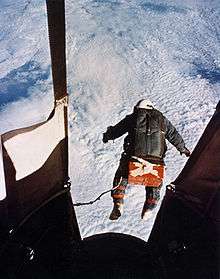
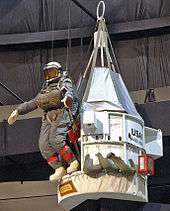
Project Excelsior
Captain Kittinger was next assigned to the Aerospace Medical Research Laboratories at Wright-Patterson AFB in Dayton, Ohio. For Project Excelsior (meaning "ever upward"), a name given to the project by Colonel Stapp as part of research into high-altitude bailouts,[2] he made a series of three extreme altitude parachute jumps from an open gondola carried aloft by large helium balloons. These jumps were made in a "rocking-chair" position, descending on his back, rather than in the usual face-down position familiar to skydivers. This was because he was wearing a 60 lb (27 kg) "kit" on his behind, and his pressure suit naturally formed a sitting shape when it was inflated, a shape appropriate for sitting in an airplane cockpit.[2]
Excelsior I : Kittinger's first high-altitude jump, from about 76,400 feet (23,300 m) on November 16, 1959, was a near-disaster when an equipment malfunction caused him to lose consciousness.[3] The automatic parachute opener in his equipment saved his life. He went into a flat spin at a rotational velocity of about 120 rpm, the g-forces at his extremities having been calculated to be over 22 times the force of gravity, setting another record.[4]
Excelsior II : On December 11, 1959, Kittinger jumped again from about 74,700 feet (22,800 m). For this leap, he was awarded the A. Leo Stevens Parachute Medal.[5]
Excelsior III : On August 16, 1960, Kittinger made the final high-altitude jump at 102,800 feet (31,300 m).[3] Towing a small drogue parachute for initial stabilization, he fell for 4 minutes and 36 seconds, reaching a maximum speed of 614 miles per hour (988 km/h)[2][6] before opening his parachute at 18,000 feet (5,500 m). Incurring yet another equipment malfunction, the pressurization for his right glove malfunctioned during the ascent and his right hand swelled to twice its normal size,[7][8] but he rode the balloon up to 102,800 feet before stepping off.[9]
"Lord, take care of me now."
Kittinger, jumping from the balloon gondola Excelsior III at 102,800 feet.[10]
Of the jumps from Excelsior, Kittinger said:[11]
"There's no way you can visualize the speed. There's nothing you can see to see how fast you're going. You have no depth perception. If you're in a car driving down the road and you close your eyes, you have no idea what your speed is. It's the same thing if you're free falling from space. There are no signposts. You know you are going very fast, but you don't feel it. You don't have a 614-mph wind blowing on you. I could only hear myself breathing in the helmet."
Kittinger set historical numbers for highest balloon ascent, highest parachute jump, longest duration drogue-fall (four minutes), and fastest speed by a human being through the atmosphere.[12] These were the USAF records, but were not submitted for aerospace world records to the Fédération Aéronautique Internationale (FAI).[13] Kittinger's record for the highest ascent was broken in 1961 by Malcolm Ross and Victor Prather. His records for highest parachute jump and fastest velocity stood for 52 years, until they were broken in 2012 by Felix Baumgartner.

For this series of jumps, Kittinger was profiled in both Life Magazine and the National Geographic Magazine, decorated with a second Distinguished Flying Cross, and awarded the Harmon Trophy by President Dwight D. Eisenhower.[14]
Project Stargazer
Back at Holloman Air Force Base, Kittinger took part in Project Stargazer on December 13–14, 1960. He and the astronomer William C. White[15] took an open-gondola helium balloon packed with scientific equipment to an altitude of about 82,200 feet (25,100 m), where they spent over 18 hours performing astronomical observations.
Later USAF career
In 1965, after returning to the operational Air Force, Kittinger was approached by civilian amateur parachutist Nick Piantanida for assistance on Pintandia's Strato Jump project, an effort to break the previous freefall records of both Kittinger and Soviet Air Force officer Yevgeni Andreyev. Kittinger refused to participate in the effort, believing Piantanida's approach to the project was too reckless. Piantanida was subsequently killed in 1966 during his Strato Jump III attempt.[16]
Kittinger later served three combat tours of duty during the Vietnam War, flying a total of 483 combat missions. During his first two tours he flew as an aircraft commander in Douglas A-26 Invaders and modified On Mark Engineering B-26K Counter-Invaders as part of Operations Farm Gate and Big Eagle.
Following his first two Vietnam tours, he returned to the United States and soon transitioned to the McDonnell Douglas F-4 Phantom II. During a voluntary third tour of duty to Vietnam in 1971–72, he commanded the 555th Tactical Fighter Squadron (555 TFS), the noted "Triple Nickel" squadron, flying the F-4D Phantom II. During this period he was credited with shooting down a North Vietnamese MiG-21 while flying an F-4D, USAF Serial No. 66-7463, with his WSO, 1st Lieutenant Leigh Hodgdon.[17]
Kittinger was shot down on May 11, 1972, just before the end of his third tour of duty. While flying an F-4D, USAF Serial No. 66-0230, with his Weapons Systems Officer, 1st Lieutenant William J. Reich, Lieutenant Colonel Kittinger was leading a flight of Phantoms approximately five miles northwest of Thai Nguyen, North Vietnam, when they were engaged by a flight of enemy MiG-21 fighters. Kittinger and his wingman were chasing a MiG-21 when Kittinger's Phantom II was hit by an air-to-air missile from another MiG-21 that damaged the Phantom's starboard wing and set the aircraft on fire. Kittinger and Reich ejected a few miles from Thai Nguyen and were soon captured and taken to the city of Hanoi. During the same engagement, Kittinger's wingman, Captain S. E. Nichols, shot down the MiG-21 they had been chasing.[18]
Kittinger and Reich spent 11 months as prisoners of war (POWs) in the Hỏa Lò Prison, the so-called "Hanoi Hilton". Kittinger was put through rope torture soon after his arrival at the POW compound and this made a lasting impression on him. Kittinger was the senior ranking officer (SRO) among the newer prisoners of war, e.g., those captured after 1969. In Kittinger's autobiography "Come Up and Get Me" (by Kittinger and Craig Ryan), Kittinger emphasized being very serious about maintaining the military structure he considered essential to survival. Kittinger and Reich were returned to American hands on March 28, 1973, and they continued their Air Force careers, with Kittinger having been promoted to full Colonel while in captivity. Following his return, Colonel Kittinger attended the Air War College at Maxwell AFB, Alabama.[19]
Following completion of the Air War College, Kittinger became the Vice Commander of the 48th Tactical Fighter Wing at RAF Lakenheath, United Kingdom, where he again flew the F-4 Phantom II. In 1977, he transferred to Headquarters, 12th Air Force, at Bergstrom AFB, Texas, retiring from the Air Force in 1978.[19][17] Kittinger accumulated 7,679 flying hours in the Air Force, including 948 combat flying hours in 425 combat missions during three tours during the Vietnam War. In addition, he has flown over 9,100 hours in various civilian aircraft.[20]
Military awards and decorations
Kittinger received the following awards and decorations during his USAF career:[21]
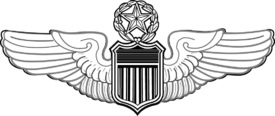 | |||
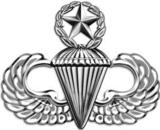 | |||
| USAF Command Pilot wings | |||||
| Master Parachutist Badge | |||||
| Silver Star w/ 1 bronze oak leaf cluster | |||||
| Legion of Merit w/ 1 bronze oak leaf cluster | Distinguished Flying Cross w/ 1 silver oak leaf cluster | Bronze Star Medal w/ Valor device and 2 bronze oak leaf clusters | |||
| Purple Heart w/ 1 bronze oak leaf cluster | Meritorious Service Medal | Air Medal w/ 4 silver oak leaf clusters | |||
| Air Medal w/ 2 bronze oak leaf clusters | Air Force Commendation Medal | Presidential Unit Citation | |||
| Air Force Outstanding Unit Award | Prisoner of War Medal | Army of Occupation Medal | |||
| National Defense Service Medal w/ 1 bronze service star |
Vietnam Service Medal w/ 1 silver and 2 bronze service stars | Air Force Longevity Service Ribbon w/ 1 silver and 1 bronze oak leaf clusters | |||
| USAF Marksmanship Ribbon | Republic of Vietnam Gallantry Cross with Palm | Republic of Vietnam Campaign Medal | |||
Later civilian career
Kittinger retired from the Air Force as a Colonel in 1978 and initially went to work for Martin Marietta (now Lockheed Martin) Corporation in Orlando, Florida. He later became Vice President of Flight Operations for Rosie O'Grady's Flying Circus, part of the Rosie O'Grady's/Church Street Station entertainment complex in Orlando, prior to the parent company's dissolution.
Still interested in ballooning, he set a gas balloon world distance record for the AA-06 size class (since broken) of 3,221.23 km in 1983.[22] He then completed the first solo balloon crossing of the Atlantic in the 106,000 cubic foot (3,000 m³) Balloon of Peace, from September 14 to September 18, 1984 organized by the Canadian promoter Gaetan Croteau.[23] As an official FAI world aerospace record, it is the longest gas balloon distance flight ever recorded in the AA-10 size category (5,703.03 km).[22] For the second time in his life, he was also the subject of a story in National Geographic Magazine.
Kittinger also participated in the Gordon Bennett Cup in ballooning in 1989 (ranked third) and 1994 (ranked 12th).
In the early 1990s, Kittinger played a lead role with NASA assisting Charles "Nish" Bruce to break his highest parachute jump record.[24] The project was suspended in 1994.
Joining the Red Bull Stratos project, Kittinger advised Felix Baumgartner on Baumgartner's October 14, 2012 free-fall from 128,100 feet (39,045m).[8] The project collected leading experts in the fields of aeronautics, medicine and engineering to ensure its success. Kittinger eventually served as CAPCOM (capsule communicator) for Baumgartner's jump, which exceeded the altitude of Kittinger's previous jump during Project Excelsior.[25][26]
As of 2013, Kittinger has been assisting balloonist Jonathan Trappe's attempt to be the first to cross the Atlantic by cluster balloon.[27]
Legacy
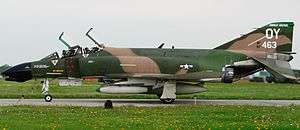
In 1997, Kittinger was inducted into the National Aviation Hall of Fame in Dayton, Ohio.[28]
On January 23, 2007, the Civil Air Patrol honored Kittinger by renaming the Texas CAP wing's TX-352 Squadron after him. Texas Governor Rick Perry cited Kittinger's work, as did the Texas state senate with a special resolution presented during the dedication ceremony attended by Kittinger and his wife, Sherry. The Colonel Joseph W. Kittinger Phantom Senior Squadron of CAP's Texas Wing is based at the former Bergstrom AFB, the site of Kittinger's last active duty assignment in the Air Force and which is now the Austin-Bergstrom International Airport.
Kittinger was honored at a 2009 ceremony in Caribou, Maine, the launch point for his 1984 solo Trans-Atlantic balloon flight. He also served as the guest of honor at the community's sesquicentennial celebration.[29][30]
On February 20, 2013, Kittinger visited his alma mater, the University of Florida, and spoke to over 400 students and faculty about his role in the Red Bull Stratos Mission.
Kittinger, a UF alumnus, told his story of when he took the 102,800-foot jump from a high-altitude balloon. This event took place during the UF Engineers Week, and it was made possible due to the efforts of the UF American Institute of Aeronautics and Astronautics, UF Air Force ROTC, and the UF College of Engineering.[31]
Kittinger Park

In September 1992, Colonel Joe Kittinger Park[32] in Orlando, Florida was completed by the Greater Orlando Aviation Authority (GOAA) for the City of Orlando. Located on the southwest corner of the Orlando Executive Airport, at the corner of Crystal Lake Drive and South Street, the park was named in Kittinger's honor, but was temporarily closed and partially demolished circa 2008-2011 in order to create a stormwater runoff retention area to permit a highway expansion project of the State Road 408 East-West Expressway. In March 2011, the park was reopened at its previous location.[33]
In Spring 2014, the Mayor of Orlando and other City of Orlando and GOAA officials approved inclusion in the park of a restored USAF F-4 Phantom II aircraft. The National Museum of the U.S. Air Force identified an F-4D previously on display in Corsicana, Texas, AF Ser. No. 65-0747, for transfer to Orlando, said aircraft to be placed on display at the park, and painted with the colors and markings of the squadron that Colonel Kittinger commanded during the Vietnam War.[34] During the transfer process, it was subsequently determined that Colonel Kittinger had also flown this particular F-4D, AF Ser. No. 65-0747, on several occasions when it was assigned to his fighter wing in Thailand during the Vietnam War, and again when it was assigned to his fighter wing in Great Britain after the war. Disassembled in Texas and transported via two semi-trailers over a period of several days, the aircraft arrived in Orlando on July 22, 2014 and underwent a total restoration by a team of volunteers at Orlando Executive Airport. Following restoration, it was subsequently moved to its new location, remounted on its new pylon, and formally dedicated on December 14, 2014.[35][36]
See also
- Parachuting
- Yevgeni Andreyev
- Michel Fournier
- Nick Piantanida
- Cheryl Stearns
- Steve Truglia
- Felix Baumgartner
- Charles "Nish" Bruce
References
- ↑ Mission to the edge of Space — Red Bull Stratos — Trailer on YouTube
- 1 2 3 4 "Factsheets: Excelsior Gondola". National Museum of the USAF.
- 1 2 John Tierney (March 15, 2010). "A Supersonic Jump, From 23 Miles in the Air". New York Times. Retrieved 2010-03-17.
In 1960, Kittinger, then a 32-year-old air force pilot, jumped from a balloon 102,800 feet above the New Mexico desert.
- ↑ "The Edge of Engineering".
- ↑ "The A. Leo Stevens Parachute Medal — A Baker's Dozen of Early Recipients". August 2011.
- ↑ "Fantastic catch in the sky, record leap toward earth". Life. August 29, 1960.
- ↑ Higgins, Matt (May 24, 2008). "20-Year Journey for 15-Minute Fall". New York Times.
- 1 2 Tony Paterson (25 January 2010). "Faster than the speed of sound: the man who falls to earth". London: The Independent. Retrieved 2011-01-18.
- ↑ Tierney, John (October 14, 2012). "Daredevil Jumps, and Lands on His Feet". New York Times.
- ↑ Joe Kittinger at the International Space Hall of Fame
- ↑ "Florida Icon: Joseph Kittinger". Florida Trend. 2011-05-31.
- ↑ Joseph W. Kittinger - USAF Museum Gathering of Eagles at the Wayback Machine (archived February 5, 2005)
- ↑ Kittinger, Joseph (2010). Come Up and Get Me. UNM Press. ISBN 978-0-8263-4804-3.
- ↑ "Joseph Kittinger, Jr.". U.S. Centennial of Flight Commission. Retrieved 2012-07-10.
- ↑ http://stratocat.com.ar/stratopedia/300.htm
- ↑ http://www.scmp.com/magazines/post-magazine/article/1008811/men-who-fall-earth
- 1 2 "Col. Joe Kittinger Jr.". USAF Heritage. Archived from the original on 2012-03-22.
- ↑ Hobson, Chris (2001). Vietnam Air Losses. Hinckley UK: Midland Publishing. p. 226. ISBN 1-85780-115-6.
- 1 2 "Kittinger"; Grier, Peter; Air Force Magazine, August 2014, p.66
- ↑ Kittinger's flying hours
- ↑ "Col. Joe Kittinger Awards". Sherri Lester-Aguirre and Sherry Kittinger. Retrieved 2012-08-06.
- 1 2 "History of Records" Joseph W. Kittinger, Jr.". FAI.
- ↑ Kittinger, Jr., Joe W. (February 1985). "The Long, Lonely Flight". National Geographic. Vol. 167 no. 2. pp. 270–276. ISSN 0027-9358. OCLC 643483454.
- ↑ Tom Read, Freefall (Little Brown, Edition 1, 1998). ISBN 0-316-64303-3.
- ↑ "Col. Joe Kittinger". Red Bull Stratos – The Team. Retrieved 14 October 2012.
- ↑ Langewiesche, William (May 2013) "The Man Who Pierced the Sky" Vanity Fair, pages 174-183; 203-204
- ↑ "Atlantic crossing beckons".
- ↑ "Records and awards". Archived from the original on 2012-03-16. Retrieved 16 March 2012.
- ↑ "Paul E. Garber Shrine". First Flight Society.
- ↑ Col. Joe Kittinger in Caribou, Maine Parade Sept 2009 on YouTube
- ↑ Kegu, Jessica. "UF alum, 84, talks about helping daredevil break his parachute jump records". The Gainesville Sun. Retrieved 30 May 2013.
- ↑ http://www.cityoforlando.net/fpr/html/Parks/JoeKittinger.htm
- ↑ "Local Aviation Hero, Colonel Joe Kittinger, Re-Opens Park in His Honor at Orlando Executive Airport". Archived from the original on 2012-03-16. Retrieved 16 March 2012.
- ↑ http://www.cityoforlando.net/elected/mayor/pressreleases/11_03_15_park.htm
- ↑ "Orlando International Airport (MCO) - Press Release - 7/22/14 F-4 Phantom Arrives at ORL".
- ↑ "F-4 Phantom Arrives in Orlando to Serve as Vietnam Vet Tribute". Warbirds News.
Further reading
- Kittinger, Joseph (1961). The Long, Lonely Leap. New York: E. P. Dutton. (Kittinger's autobiography)
- Kennedy, Gregory P. (2007). Touching Space: the story of Project Manhigh. Schiffer. ISBN 0-7643-2788-7.
- Ryan, Craig (1995). The Pre-Astronauts: Manned Ballooning on the Threshold of Space. Naval Institute Press. ISBN 1-55750-732-5.
- Kittinger, Joseph (2010). Come Up and Get Me. Albuquerque: University of New Mexico Press. ISBN 0-8263-4803-3.
External links
| Wikimedia Commons has media related to Joseph Kittinger. |
| Records | ||
|---|---|---|
| Preceded by None |
Highest space dive (23.287 km) 16 November 1959 – 16 August 1960 |
Succeeded by Joseph Kittinger |
| Preceded by Joseph Kittinger |
Highest space dive (31.333 km) 16 August 1960 – 14 October 2012 |
Succeeded by Felix Baumgartner |